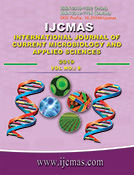


 National Academy of Agricultural Sciences (NAAS)
National Academy of Agricultural Sciences (NAAS)

|
PRINT ISSN : 2319-7692
Online ISSN : 2319-7706 Issues : 12 per year Publisher : Excellent Publishers Email : editorijcmas@gmail.com / submit@ijcmas.com Editor-in-chief: Dr.M.Prakash Index Copernicus ICV 2018: 95.39 NAAS RATING 2020: 5.38 |
Coscinium fenestratum (Gaertn.) Colebr, commonly called as daruharidra which belongs to Menispermaceae family is rich with bioactive secondary metabolites that might signify valuable leads in the production of new pharmaceutical agents. The metabolite accumulation in the plants varies with the environmental factors, expression level of enzymes, climatic conditions etc. To evaluate the difference of metabolite in the cultivated vine, the sample was analysed by High performance Liquid Chromatography-Mass Spectrometry (HPLC-MS). So, in this study, we choose cultivated Coscinium fenestratum (Gaertn.) Colebr, (daruharidra) as study object and leaf and stem tissues were selected as samples and the metabolite content was analysed by chromatographic method. HPLC-MS with the electrospray (ES) ionization chamber were very efficient in ionizing in the positive ion mode (ES+) and the analytes being heterocyclic compounds predominantly protonated and was determined based on its molecular weight, retention time and the available library database. Thus the compounds deciphered were berberine, jatrorrhizine, palmatine, tetrahydropalmatine, tetrahydroberberine, magnoflorine, isocorydine, glaucine an alkaloid related to protoberberine and aporphine group of alkaloids and ecdysterone a plant sterol compound were identified in both leaf and stem sample.
 |
 |
 |
 |
 |